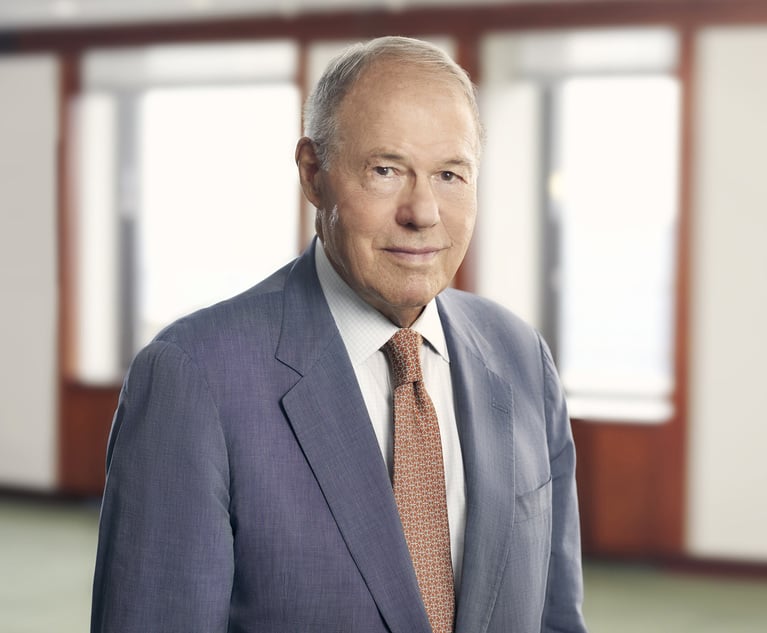 Photo: Mike Scarcella/ALM
Photo: Mike Scarcella/ALMCourt Won't Dismiss Claims Against HSBC Bank in Jewelry Theft Case
In a split decision, a majority Appellate Division, First Department, panel has decided that HSBC, which issued a crucial credit reference letter on behalf of a thieving jewelry dealer, must continue to face the two causes of action, which should not be dismissed.
January 03, 2019 at 06:20 PM
7 minute read
A lawsuit levied against HSBC Bank on claims of aiding and abetting fraud and conversion—allegedly helping to lead to the theft of $425,750 worth of watches and jewelry auctioned off to a scheming dealer—must go forward, a state appeals court has ruled.
In a split decision, a majority Appellate Division, First Department, panel has decided that HSBC, which issued a credit reference letter on behalf of the jewelry dealer, must continue to face the two causes of action—and they should not be dismissed—in part because the “HSBC letter clearly represented to plaintiff [an auctioneer and appraiser auctioning the items] that [jewelry dealer Brett] Stettner's accounts contained a minimum of $1,000,000, an amount that was specific, and that was sufficient to cover Stettner's $425,750.00 check” that later bounced.
“The letter was thus a statement of existing fact, as opposed to a 'nonactionable opinion' or 'a prediction as to future performance,'” the majority panel, composed of Justices Rosalyn Richter, Angela Mazzarelli, Ellen Gesmer and Peter Moulton, wrote, quoting FMC v. Fleet Bank.
The majority also later noted that HSBC “had the means to verify if it [the letter] was accurate.”
Justice Peter Tom, the lone dissenting judge in the Dec. 20 opinion, countered that the credit reference letter “referred only generally to Stettner's 'average balances' in the plural on a 'worldwide' basis … [and] stating a customer's average balances across multiple accounts and throughout the world is no guarantee or representation regarding the balance in one account at that time or, as relevant here, on a future date.”
The lawsuit springs out of a 2012 theft pulled off by Stettner, who on his website describes himself as a “renowned diamond, gem and jewelry specialist” who is “known as a 'dealer's dealer,'” against William Doyle Galleries. William Doyle auctioned off 28 items to Stettner valued at $425,750.
According to Tom's dissent and news reports, between 2012 and 2015, Stettner went to various Manhattan-based auctions—including at Christie's and Sotheby's—was the high bidder on jewelry and watches, and then presented checks to the auction houses that were eventually rejected for insufficient funds.
Tom wrote that Stettner obtained hundreds of thousands of dollars' worth of watches and jewelry, and attempted to take possession of additional items worth millions of dollars. In the case of Christie's and Sotheby's, he never was able to obtain the items he bid on. But William Doyle eventually gave him its jewelry and antique watches, the opinion and news reports say.
Then in August 2015, Stettner was arrested and indicted for several thefts against Manhattan auction houses, including the theft from William Doyle Galleries, the majority wrote.
On May 6, 2016, he pleaded guilty to charges filed against him, and subsequently was sentenced and ordered to pay restitution.
In June 2017, William Doyle filed suit in Manhattan Supreme Court against Stettner and HSBC, with causes of action against the bank including aiding and abetting fraud, and aiding and abetting conversion, according to Tom. At that time, said William Doyle's complaint, Stettner still owed $122,000 for the watches and jewelry he'd fraudulently obtained.
As the First Department majority justices and Tom recounted, it was the bank's credit reference letter issued on behalf of Stettner to William Doyle that brought it into the suit.
Once he became a successful auction bidder on April 6, 2012, for the $425,750 worth of items, he presented a check postdated May 16, 2012, as payment, which William Doyle declined to accept without a credit reference, the justices wrote.
But then, said the justices while citing William Doyle's complaint, an HSBC Bank USA vice president represented to William Doyle that Stettner had longstanding banking relationships with HSBC in the United States and Hong Kong, and that his account was sufficient to cover the check.
William Doyle still said it needed something in writing, both the majority and Tom recounted, after which the vice president issued a letter saying Stettner had relationships with HSBC for his “various international business needs”; HSBC and Stettner had a “high level relationship”; the valued “worldwide relationships” had been in good standing and there had been no problems for four years with the “accounts,” since 2008; and “worldwide the average balances can fluctuate from $1 [million] to $20 [million].”
In reversing Manhattan Supreme Court Justice Gerald Lebovits, who in February 2018 dismissed all counts brought by William Doyle against HSBC, the majority first rejected “HSBC's argument that plaintiff's pleading of an underlying fraud was defective because it failed to plead the misrepresentation of a present or existing fact.”
“Here, the HSBC letter made representations about Stettner's bank balances as they existed at the time the letter was written,” the four justices wrote.
Moreover, they said, “we disagree with HSBC that the letter's use of the language 'can fluctuate' precludes the letter from establishing a misrepresentation of a present or existing fact.”
“The HSBC letter clearly represented to plaintiff that Stettner's accounts contained a minimum of $1,000,000, an amount that was specific, and that was sufficient to cover Stettner's $425,750.00 check,” the majority continued, adding that “the letter was thus a statement of existing fact, as opposed to a 'nonactionable opinion' or 'a prediction as to future performance.'”
The majority justices also wrote in William Doyle Galleries, Inc. v. Brett Stettner and HSBC Bank USA, N.A. that “Stettner admitted [in his guilty plea allocution] that he knew that the [reference] letter that he provided plaintiff contained false information about his bank balances.”
They continued, “HSBC was the source of that letter, and had the means to verify if it was accurate. Prior to providing the letter, HSBC verbally represented that Stettner and HSBC had a long-standing relationship and that his accounts contained funds sufficient to cover the check. These allegations are sufficient, on this prediscovery, pre-answer motion, to plead that HSBC knew that the letter contained misrepresentations about Stettner's accounts.
“Indeed, this court has declined to 'endorse what is essentially a “see no evil, hear no evil” approach' when reviewing whether a cause of action for aiding and abetting fraud adequately pleads actual knowledge,” the justices wrote, citing AIG Financial Products, quoting Oster.
In dissent, Tom wrote that “significantly, the check here was postdated and first eligible for presentment several weeks after HSBC issued the letter, so it was impossible for the letter to state whether the balance would be adequate in the future because of possible withdrawal activity in the account during the interim.”
At another point, Tom wrote that “critically, the majority's holding would subject banking institutions to potential liability any time they issue an accurate reference letter and the account holder later decides to withdraw funds to prevent the collection of an issued check. This would lead to an unreasonable and unjustifiable result.”
The attorney for HSBC, Brian McGrath of McGlinchey Stafford in Manhattan, declined to comment.
William Doyle Galleries' lawyer, Barry Lichtenberg of Lichtenberg PLLC in Manhattan, said on Thursday that he and William Doyle “are pleased with the First Department's decision.” He said he declined to comment otherwise at this time.
This content has been archived. It is available through our partners, LexisNexis® and Bloomberg Law.
To view this content, please continue to their sites.
Not a Lexis Subscriber?
Subscribe Now
Not a Bloomberg Law Subscriber?
Subscribe Now
NOT FOR REPRINT
© 2025 ALM Global, LLC, All Rights Reserved. Request academic re-use from www.copyright.com. All other uses, submit a request to [email protected]. For more information visit Asset & Logo Licensing.
You Might Like
View All
Meet the Long Island Judge Tapped to Be US Attorney for Eastern District of New York
2 minute read
New York’s Property Tax Incentives and Abatements Make Development Feasible
7 minute read
Josef Partners With NYU, Housing Court Answers to Launch AI Assistant Built for Tenants

Trending Stories
- 1The Appropriate Exemption in Students for Fair Admissions v. President & Fellows of Harvard College
- 2DOJ, 10 State AGs File Amended Antitrust Complaint Against RealPage and Big Landlords
- 3New Partners at Cummings & Lockwood, Carmody Torrance Sandak & Hennessey
- 4'Extra Government'?: NY Top Court Eyes Ethics Commission's Constitutionality
- 5South Texas College of Law Houston Selects New Dean
Who Got The Work
Michael G. Bongiorno, Andrew Scott Dulberg and Elizabeth E. Driscoll from Wilmer Cutler Pickering Hale and Dorr have stepped in to represent Symbotic Inc., an A.I.-enabled technology platform that focuses on increasing supply chain efficiency, and other defendants in a pending shareholder derivative lawsuit. The case, filed Oct. 2 in Massachusetts District Court by the Brown Law Firm on behalf of Stephen Austen, accuses certain officers and directors of misleading investors in regard to Symbotic's potential for margin growth by failing to disclose that the company was not equipped to timely deploy its systems or manage expenses through project delays. The case, assigned to U.S. District Judge Nathaniel M. Gorton, is 1:24-cv-12522, Austen v. Cohen et al.
Who Got The Work
Edmund Polubinski and Marie Killmond of Davis Polk & Wardwell have entered appearances for data platform software development company MongoDB and other defendants in a pending shareholder derivative lawsuit. The action, filed Oct. 7 in New York Southern District Court by the Brown Law Firm, accuses the company's directors and/or officers of falsely expressing confidence in the company’s restructuring of its sales incentive plan and downplaying the severity of decreases in its upfront commitments. The case is 1:24-cv-07594, Roy v. Ittycheria et al.
Who Got The Work
Amy O. Bruchs and Kurt F. Ellison of Michael Best & Friedrich have entered appearances for Epic Systems Corp. in a pending employment discrimination lawsuit. The suit was filed Sept. 7 in Wisconsin Western District Court by Levine Eisberner LLC and Siri & Glimstad on behalf of a project manager who claims that he was wrongfully terminated after applying for a religious exemption to the defendant's COVID-19 vaccine mandate. The case, assigned to U.S. Magistrate Judge Anita Marie Boor, is 3:24-cv-00630, Secker, Nathan v. Epic Systems Corporation.
Who Got The Work
David X. Sullivan, Thomas J. Finn and Gregory A. Hall from McCarter & English have entered appearances for Sunrun Installation Services in a pending civil rights lawsuit. The complaint was filed Sept. 4 in Connecticut District Court by attorney Robert M. Berke on behalf of former employee George Edward Steins, who was arrested and charged with employing an unregistered home improvement salesperson. The complaint alleges that had Sunrun informed the Connecticut Department of Consumer Protection that the plaintiff's employment had ended in 2017 and that he no longer held Sunrun's home improvement contractor license, he would not have been hit with charges, which were dismissed in May 2024. The case, assigned to U.S. District Judge Jeffrey A. Meyer, is 3:24-cv-01423, Steins v. Sunrun, Inc. et al.
Who Got The Work
Greenberg Traurig shareholder Joshua L. Raskin has entered an appearance for boohoo.com UK Ltd. in a pending patent infringement lawsuit. The suit, filed Sept. 3 in Texas Eastern District Court by Rozier Hardt McDonough on behalf of Alto Dynamics, asserts five patents related to an online shopping platform. The case, assigned to U.S. District Judge Rodney Gilstrap, is 2:24-cv-00719, Alto Dynamics, LLC v. boohoo.com UK Limited.
Featured Firms
Law Offices of Gary Martin Hays & Associates, P.C.
(470) 294-1674
Law Offices of Mark E. Salomone
(857) 444-6468
Smith & Hassler
(713) 739-1250






